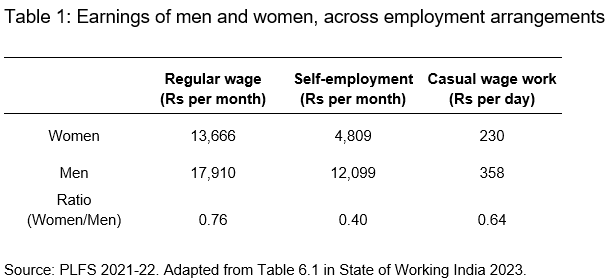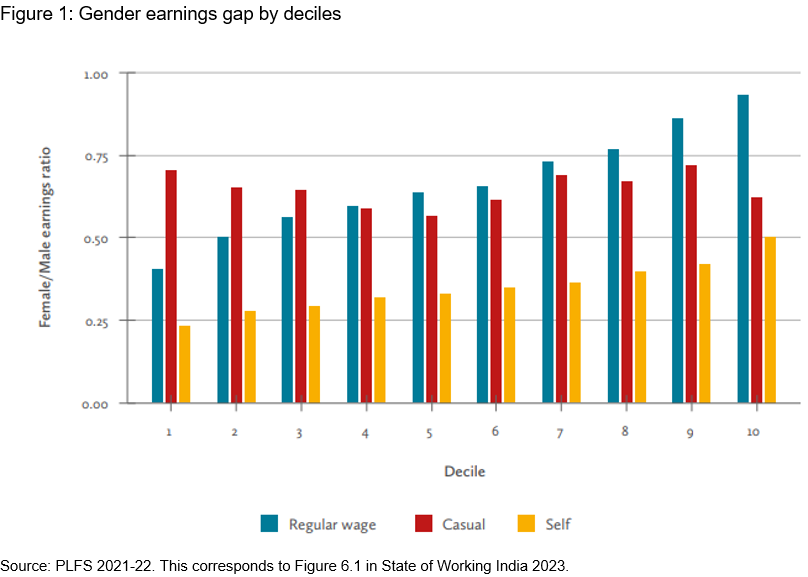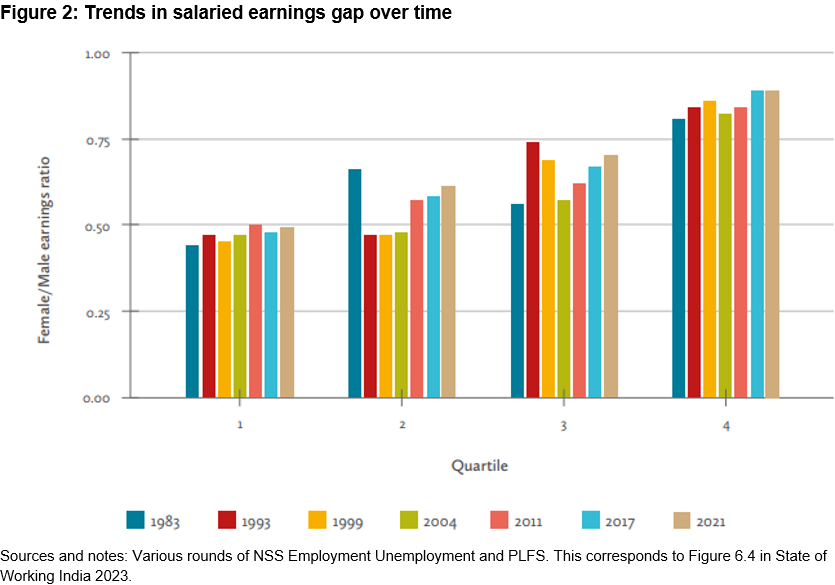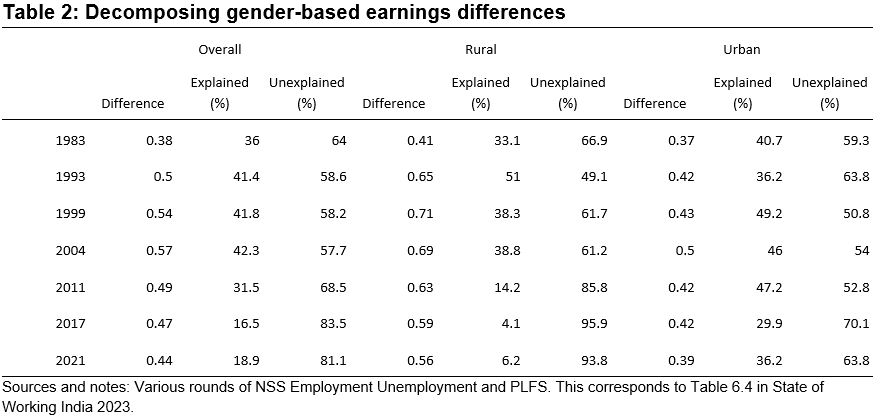Economic Growth, Structural Change, and Women’s Earnings in India
In India, the process of structural transformation has resulted in a large change in the composition of the female workforce. Older, less educated women have exited while younger more educated women have entered. The former have received much more attention in the form of the debate over declining female labor force participation. In 1983, about 33 percent of working age rural women were in paid employment. By 2017, this had fallen to about 20 percent. Employment rates have since risen for women in rural India. However, the second aspect of the compositional shift is also equally significant, manifested in the rising share of women in salaried employment accompanied by a declining share of women in casual wage work. Selected findings from the State of Working India Report 2023 focus on the implications of this fact on women’s earnings and the gender-based earnings gap using evidence from official employment surveys.
Earnings Gap Across Employment Types
A compositional shift away from casual wage work toward regular wage employment narrows the gender earnings gap because the gap tends to be larger in the former. In 2021-22, the average monthly earnings of a regular salaried man was approximately Rs. 17,910. A salaried woman earned about Rs. 13,666. In casual wage work, the earnings disparity was higher, with women earning only 60 percent of what men earn. Unfortunately, the share of women in self-employment has remained stagnant over most of the post-reform period (and has even increased during the Covid and post-Covid period). This is a matter of concern because the earnings gap is highest in the case of self-employment, with women, on average, earning only 40 percent of men’s earnings.

How do these disparities play out across the earnings distribution? As women move up the earnings ladder, are they earning closer to what men make or does the gap widen even further? Figure 1 (below) gives us an answer to this question. For each type of employment, we divide the earnings into ten groups representing the lowest (decile 1) and highest earners (decile 10). As we see in Table 1, across the earnings distribution, self-employment has the highest gender-based earnings gap. By contrast, salaried employment has a much lower earnings gap and, in fact, this gap steadily narrows as one moves up the earnings distribution. In the top of the salaried earnings spectrum, women earn 90 percent of what men earn, on average. For self-employment on the other hand, the earnings gap is still high, with women earning around 60 percent of what men make. Although the gender earnings gap in self-employment narrows as one moves up the earnings distribution, it remains quite high.

Trends in Earnings Gap Over Time
Official estimates of earnings from self-employment have only been collected since 2017, whereas we have information on wage earnings from the 1980s onwards. Figure 2 shows the long run trends in earnings gap for salaried workers within each quartile group over time.

Explaining the Trends
Clearly, over time, there has been a narrowing of the earnings gap, particularly in the second and third quartiles. Two possibilities can explain this narrowing trend. One, gender-based discrimination in the labor market may have decreased over time, with employers treating men and women similarly. Or it could be that the very nature of women participating in the labor market (vis-à-vis men) has changed, with more educational attainment among women as well as an improvement in the kinds of occupations and industries they had access to within regular salaried employment.
As mentioned earlier, over this period, a large change has occurred in the composition of the female workforce. Older, less educated women have exited while younger, more educated women have entered. Fewer women are employed in agriculture and more and more women are in the services sector.
To discern how much these compositional changes explain the changes in the earnings gap over time, we use a standard decomposition technique. The Kitagawa-Oaxaca-Blinder decomposition considers the average earnings difference between men and women and identifies the extent to which this difference can be attributed to “explained differences,” i.e., differences in observable characteristics between the two groups, and to “unexplained differences,” i.e., differences in unobservable characteristics. Observable characteristics include education, marital status, number of children, industry, and occupation of employment. The unobservable component is often interpreted as measuring discrimination, but it can also include the effect of omitted characteristics for which data is not available.
Table 2 shows the extent of the explained and unexplained components over time. From 1983 onward, there is a steady decline in the explained component. This reflects how the characteristics of men and women in the labor market have, over time, become similar and, hence, explain less and less of the gender wage gap. By 2021-22, about 80 percent of the earnings gap is attributable to this unexplained component.

This increase is more dramatic in the case of the rural workforce where more than 90 percent of the gender wage gap in 2021-22 was not explained by workers’ characteristics. But the period that saw a rapid rise in the female salaried workforce (1999 to 2017) did also see a rise in the unexplained component in urban India as well. Thus, the finding is a general one. Finally, the size of the gap itself increased substantially in rural India but the increase is much less pronounced in urban areas. The larger conclusion is worth emphasizing. The same period that saw a rapid rise in regular wage work among women also saw an increase in the unexplained part of the gender wage gap, usually attributed to discrimination.
The last two decades have seen a large churn in the Indian female workforce. The increase in the share of women as salaried workers is good news. However, this increase has not led to a systematic reduction in the unexplained earnings gap. Rather, educational convergence has revealed the potential role of discrimination in causing the gap. Even with an increase in education and improved access to non-agricultural employment, women continue to earn less than men. But once again, it is encouraging that, as one moves up the earnings ladder, the gap reduces, which may reflect less discriminatory conditions for women in relatively more formal parts of the economy. Therefore, policy responses that encourage improved access to education for girls and enable the expansion of formal employment can help narrow the gap.
The analysis presented here was assisted by Hami Ameen, Research Associate at Azim Premji University.


